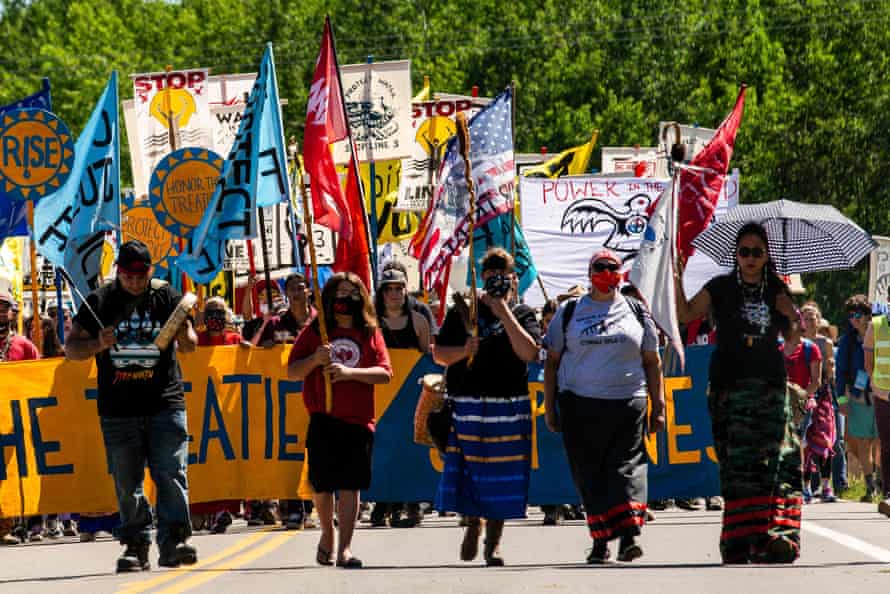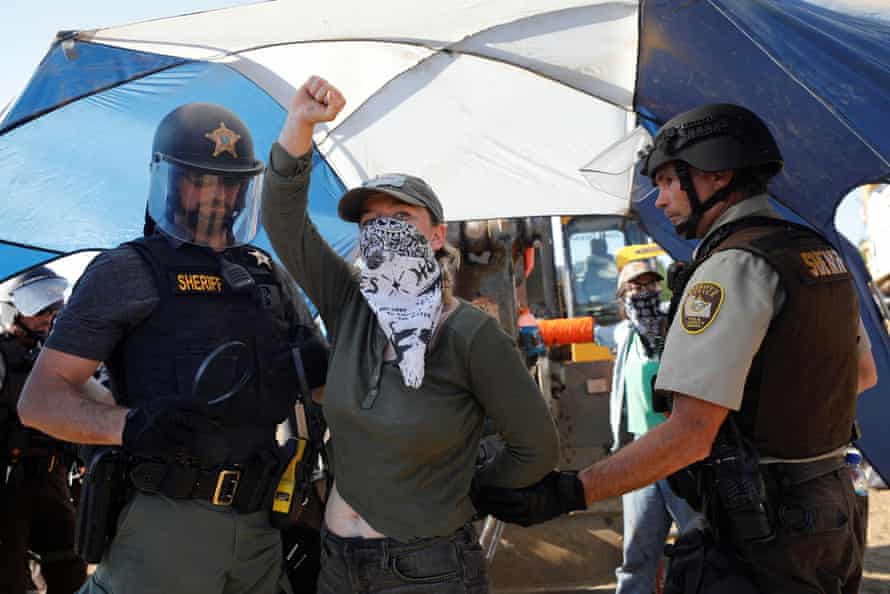Environmental protesters and Native American tribes have joined together to try to block construction efforts that would expand and repair a controversial pipeline called Line 3, which would carry hundreds of thousands of barrels of oil through tribal lands and fragile watersheds in northern Minnesota.
The protesters said they were there as water and land protectors, fighting Enbridge, a Canadian-owned company, and the $9bn upgrade of the pipeline. The action sparked a confrontation with law enforcement officers and raised the prospects of a high-profile fight set to highlight the use of fossil fuels at a time of growing climate crisis.
Earlier this week, police made mass arrests of people who had chained themselves to construction equipment and barricaded a road to a construction site off Highway 71 north of Park Rapids with an old fishing boat and other obstacles. Police also used a sonic device known as a long-range acoustic device, or LRAD, on the protesters.
Representatives of the legal aid non-profit National Lawyers Guild, who were present at the protest, said more than 100 people had been arrested. US Customs and Border Protection sent a helicopter that hovered 20 to 25ft over a group of protesters occupying a pump station, kicking up clouds of dust and debris.

“We continue on our path to resistance until the proper intervention by the Biden administration is done, which is suspending the water crossing permits and ordering a full environmental review,” said Tara Houska, a tribal attorney and the founder of the advocacy organization Giniw Collective. “That’s what I am here to protect.”
The project, which received its final approvals under Donald Trump, is a 340-mile rerouting of a wider pipeline network. Once completed, it would carry 760,000 barrels of tar-sands oil a day from Alberta, Canada, across northern Minnesota and into Wisconsin to the tip of Lake Superior. The trip takes oil across 200 bodies of water, including the headwaters of the Mississippi River, and the area is also home to traditional wild rice harvesting.
Participants called on Joe Biden to stop Line 3, which opponents say threatens northern Minnesota’s waters, the global climate, and Anishinaabe treaty rights.
“Our ancestors made agreements to take care of this water and land for ever together, and now is our time to do that.” said Winona LaDuke of Honor the Earth in a statement.
Several Ojibwe tribes and environmental groups have opposed the pipeline, arguing in court that the line poses significant environmental risks to sensitive waterways and areas where tribal members hunt, fish and gather food.
In a statement issued on Monday, Enbridge said it had to evacuate 44 workers from the site, including 10 employees of a Native-owned contractor from the White Earth Reservation. “The project is already providing significant economic benefits for counties, small businesses, Native American communities, and union members – including creating 5,200 family-sustaining construction jobs, and millions of dollars in local spending and tax revenues,” the company wrote.
Biden’s administration has put environmental justice forward as a priority – but it remains to be seen how they react to thorny issues such as fossil fuel infrastructure, said Dana Powell, an anthropologist at Appalachian State University who studies indigenous resistance movements.

She added that the Enbridge project was particularly interesting because it was not proposed future infrastructure like the Dakota Access pipeline, which garnered huge protests in 2016. Instead, Line 3 is an existing pipeline that is old, corroded and falling down.
“So we have a choice in front of us: are we investing billions of dollars into the restoration and upgrade of old infrastructure or maybe investing in different kinds of systems,” she says.
Indigenous-led resistance is just part of a broader movement that has gone back centuries, said Ben Railton, an American studies professor at Fitchburg State University. He said that, especially in the US, people tend to think about Native Americans throughout history either as vanishing or victims. “They are either tragically lost or gone from a present tense, or seen as victims like Trail of Tears, unjust laws and genocides,” Railton said.
But history is actually awash with examples of Indigenous groups engaging in active resistance to change the laws or infringement on land. Railton points to the protests at Standing Rock, when thousands of protesters tried to stop the construction of the Dakota Access pipeline in 2016 and 2017 – it was the largest gathering of native peoples in more than 100 years.
This is a 21st-century moment of solidarity and collective action, from Occupy Wall Street to Black Lives Matter, says Railton.
He added: “But this moment is also building on a great legacy and taking it another step.”